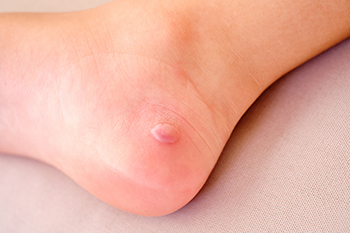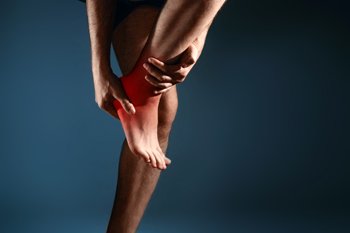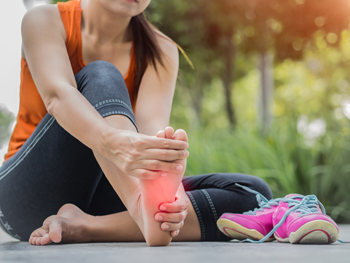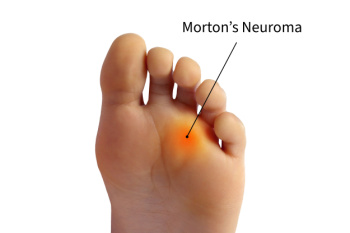Items filtered by date: July 2025
What You Need to Know About Diabetic Blisters on the Feet

Diabetic blisters are rare but serious skin complications that can appear on the feet of people with diabetes. These blisters can form without injury and are often linked to poor blood sugar control and nerve damage, called neuropathy. They typically appear suddenly as fluid-filled sacs on the toes, heels, or soles. While they are usually painless, the skin around them may feel tight or itchy. Left untreated, they can become infected and lead to more serious complications. A podiatrist can evaluate the blister, ensure it is healing properly, and help prevent infection. Treatment usually includes protecting the area with sterile dressings, managing blood sugar levels, and checking for signs of infection. Regular foot care is essential for people with diabetes to prevent further problems. If you are dealing with this issue, it is suggested that you make an appointment with a podiatrist.
Blisters may appear as a single bubble or in a cluster. They can cause a lot of pain and may be filled with pus, blood, or watery serum. If your feet are hurting, contact Jennifer M. Kern, DPM of South Carolina. Our doctor can provide the care you need to keep you pain-free and on your feet.
Foot Blisters
Foot blisters are often the result of friction. This happens due to the constant rubbing from shoes, which can lead to pain.
What Are Foot Blisters?
A foot blister is a small fluid-filled pocket that forms on the upper-most layer of the skin. Blisters are filled with clear fluid and can lead to blood drainage or pus if the area becomes infected.
Symptoms
(Blister symptoms may vary depending on what is causing them)
- Bubble of skin filled with fluid
- Redness
- Moderate to severe pain
- Itching
Prevention & Treatment
In order to prevent blisters, you should be sure to wear comfortable shoes with socks that cushion your feet and absorb sweat. Breaking a blister open may increase your chances of developing an infection. However, if your blister breaks, you should wash the area with soap and water immediately and then apply a bandage to the affected area. If your blisters cause severe pain it is important that you call your podiatrist right away.
If you have any questions, please feel free to contact our office located in West Columbia, SC . We offer the newest diagnostic and treatment technologies for all your foot care needs.
Ankle Fracture? Don’t Wait for Treatment
Common Problems That Affect Aging Feet

As we grow older, our feet experience natural changes that can lead to discomfort and mobility issues. The skin becomes thinner and drier, fat pads on the soles wear down, and circulation may slow. These shifts can make walking or standing more difficult and increase the risk of injury. Common problems include bunions, hammertoes, arthritis, and thickened or brittle toenails. Many seniors also develop calluses, corns, or changes in foot shape that make shoes less comfortable. Nerve sensitivity may decline, making it harder to notice pain or injury, especially in those with diabetes or vascular conditions. Staying active, wearing supportive footwear, and inspecting the feet regularly can help reduce the impact of these issues. Foot discomfort should never be seen as an acceptable part of aging. If you notice ongoing pain, numbness, or changes in how your feet feel or function, it is suggested you consult a podiatrist for evaluation and personalized care.
If you need your feet checked, contact Jennifer M. Kern, DPM of South Carolina. Our doctor will attend to all of your foot and ankle needs and provide you with quality treatment.
Geriatrics and Podiatry
When people age, some common issues that may occur are bone density loss, dry skin, poor circulation, and rough brittle nails. These issues may also affect your foot health if the necessary steps are not taken to alleviate the problems.
It is important to take care of your feet because feet that are injured or diseased can affect your overall health. Having painful feet hinders your ability to do daily activities or may decrease your willingness to do the things that you need to do.
Visiting Your Geriatrician
As we age, health problems become more likely, so it is essential to visit your doctor for check-ups to ensure that you are doing the best you can to take care of your health. It is recommended to check your feet frequently for any possible cuts, bruises, swelling, corns or any other irregularities.
Taking Care of Elderly Feet
Cracked or dry feet can be treated by applying moisturizer often. It is also important not to wear old socks because the older the sock is, the higher the possibility there will be that there is bacteria there. Wear fresh socks and make sure they fit properly.
Proper foot health means that you can have a more active lifestyle and you will not be bogged down by pain. Foot health also leads to good circulation, which is paramount for overall health.
If you have any questions, please feel free to contact our office located in West Columbia, SC . We offer the newest diagnostic tools and technology to treat your foot and ankle needs.
What You Should Know About Heel Pain

Heel pain is one of the most common foot complaints and can stem from a variety of causes. One frequent source is strain on the tissue that runs along the bottom of the foot, which can lead to soreness near the heel, especially in the morning or after periods of rest. Other possible causes include inflammation of the heel’s growth plate, irritation of surrounding tendons, or pressure from improper footwear. Sometimes the pain may come on gradually, while in other cases it may feel sharp and sudden. Activity level, foot shape, and age can all influence the risk of developing heel pain. Addressing the problem early often helps prevent it from becoming a long-term issue. If your heel continues to hurt or affects how you walk, it is suggested that you see a podiatrist to determine the cause and find the most effective solution.
Many people suffer from bouts of heel pain. For more information, contact Jennifer M. Kern, DPM of South Carolina. Our doctor can provide the care you need to keep you pain-free and on your feet.
Causes of Heel Pain
Heel pain is often associated with plantar fasciitis. The plantar fascia is a band of tissues that extends along the bottom of the foot. A rip or tear in this ligament can cause inflammation of the tissue.
Achilles tendonitis is another cause of heel pain. Inflammation of the Achilles tendon will cause pain from fractures and muscle tearing. Lack of flexibility is also another symptom.
Heel spurs are another cause of pain. When the tissues of the plantar fascia undergo a great deal of stress, it can lead to ligament separation from the heel bone, causing heel spurs.
Why Might Heel Pain Occur?
- Wearing ill-fitting shoes
- Wearing non-supportive shoes
- Weight change
- Excessive running
Treatments
Heel pain should be treated as soon as possible for immediate results. Keeping your feet in a stress-free environment will help. If you suffer from Achilles tendonitis or plantar fasciitis, applying ice will reduce the swelling. Stretching before an exercise like running will help the muscles. Using all these tips will help make heel pain a condition of the past.
If you have any questions please contact our office located in West Columbia, SC . We offer the newest diagnostic and treatment technologies for all your foot and ankle needs.
Foot Problems That Can Affect Runners

Running is a high-impact activity that can lead to a variety of foot-related issues, especially when shoes do not fit well or training is too intense. Pain in the heel is a common complaint, often caused by irritation of the tissue along the bottom of the foot. Small cracks in the bone, called stress fractures, may develop from repetitive motion, and are typically painful during activity. Tightness or discomfort at the back of the ankle may signal inflammation of the tendon that supports that area. Runners might also deal with skin problems like blisters or bruised toenails from friction. Discomfort in the forefoot or worsening of conditions like bunions can also occur with long runs or poor support. Paying attention to early signs of pain and choosing proper footwear can reduce the risk. If running leads to foot pain or changes that do not resolve, it is suggested that you see a podiatrist for a diagnosis and appropriate treatment.
Exercising your feet regularly with the proper foot wear is a great way to prevent injuries. If you have any concerns about your feet, contact Jennifer M. Kern, DPM of South Carolina. Our doctor will treat your foot and ankle needs.
How to Prevent Running Injuries
Many common running injuries are caused by overuse and overtraining. When the back of the kneecap starts wearing out and starts causing pain in your knee, this is commonly referred to as runner’s knee. Runner’s knee is a decrease in strength in your quadriceps and can occur if you’re not wearing properly fitted or supporting shoes. To prevent runner’s knee, focusing on hip strengthening is a good idea, as well as strengthening your quads to keep the kneecaps aligned.
What Are Some Causes of Running Injuries?
- One cause of a common running injury is called iliotibial band syndrome.
- Plantar fasciitis is also another common injury.
- Stress fractures can occur from overtraining, lack of calcium, or even your running style.
Best Ways to Prevent Running Injuries
- Wear footwear that fits properly and suits your running needs.
- Running shoes are the only protective gear that runners have to safeguard them from injury.
- Make a training schedule. Adding strengthening exercises as well as regular stretching can help keep you strong and limber and can lessen the possibility of injuries.
- Stretching keeps muscles limber; this will help you gain better flexibility.
If you have any questions please feel free to contact our office located in West Columbia, SC . We offer the newest diagnostic and treatment technologies for all your foot and ankle needs.
Understanding Morton's Neuroma

Morton's neuroma is a painful condition caused by the thickening of tissue surrounding a nerve between the toes, most commonly between the third and fourth toes. This thickening results from irritation, pressure, or injury, often linked to wearing tight or high-heeled shoes or from repetitive stress. Symptoms include sharp, burning pain in the ball of the foot, numbness, tingling, or a feeling of a pebble stuck under the foot. The affected area may be tender to touch, and discomfort typically worsens when walking or wearing tight footwear. A podiatrist diagnoses Morton's neuroma through a physical exam and may use imaging tests like ultrasound or MRI scans to confirm. Treatment options include changing footwear, custom orthotics, corticosteroid injections, or targeted exercises. In severe cases, surgery may be necessary to remove the affected or surrounding tissue. If you have pain in this part of your foot, it is suggested that you schedule an appointment with a podiatrist who can accurately diagnose and treat Morton's neuroma.
Morton’s neuroma is a very uncomfortable condition to live with. If you think you have Morton’s neuroma, contact Jennifer M. Kern, DPM of South Carolina. Our doctor will attend to all of your foot care needs and answer any of your related questions.
Morton’s Neuroma
Morton's neuroma is a painful foot condition that commonly affects the areas between the second and third or third and fourth toe, although other areas of the foot are also susceptible. Morton’s neuroma is caused by an inflamed nerve in the foot that is being squeezed and aggravated by surrounding bones.
What Increases the Chances of Having Morton’s Neuroma?
- Ill-fitting high heels or shoes that add pressure to the toe or foot
- Jogging, running or any sport that involves constant impact to the foot
- Flat feet, bunions, and any other foot deformities
Morton’s neuroma is a very treatable condition. Orthotics and shoe inserts can often be used to alleviate the pain on the forefront of the feet. In more severe cases, corticosteroids can also be prescribed. In order to figure out the best treatment for your neuroma, it’s recommended to seek the care of a podiatrist who can diagnose your condition and provide different treatment options.
If you have any questions, please feel free to contact our office located in West Columbia, SC . We offer the newest diagnostic and treatment technologies for all your foot care needs.




